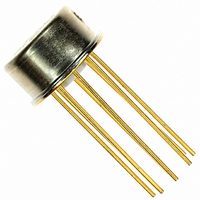AD549LHZ Analog Devices Inc, AD549LHZ Datasheet - Page 13

AD549LHZ
Manufacturer Part Number
AD549LHZ
Description
IC OPAMP GP 1MHZ LP 20MA TO99-8
Manufacturer
Analog Devices Inc
Series
Topgate™r
Datasheet
1.AD549JHZ.pdf
(20 pages)
Specifications of AD549LHZ
Slew Rate
3 V/µs
Amplifier Type
General Purpose
Number Of Circuits
1
Gain Bandwidth Product
1MHz
Current - Input Bias
0.04pA
Voltage - Input Offset
300µV
Current - Supply
600µA
Current - Output / Channel
20mA
Voltage - Supply, Single/dual (±)
±5 V ~ 18 V
Operating Temperature
0°C ~ 70°C
Mounting Type
Through Hole
Package / Case
TO-99-8, Metal Can
Op Amp Type
Low Bias Current
No. Of Amplifiers
1
Bandwidth
1MHz
Supply Voltage Range
± 5V To ± 18V
Amplifier Case Style
TO-99
No. Of Pins
8
Lead Free Status / RoHS Status
Lead free / RoHS Compliant
Output Type
-
-3db Bandwidth
-
Lead Free Status / Rohs Status
RoHS Compliant part
Electrostatic Device
Available stocks
Company
Part Number
Manufacturer
Quantity
Price
Part Number:
AD549LHZ
Manufacturer:
ADI/亚德诺
Quantity:
20 000
DIFFERENTIAL INPUT VOLTAGE OVERLOAD
A plot of the AD549 input currents vs. differential input
voltage (defined as V
input current at either terminal stays below a few hundred
femtoamps until one input terminal is forced higher than 1 V
to 1.5 V above the other terminal. Under these conditions, the
input current limits at 30 μA.
INPUT PROTECTION
The AD549 safely handles any input voltage within the supply
voltage range. Subjecting the input terminals to voltages beyond
the power supply can destroy the device or cause shifts in input
current or offset voltage if the amplifier is not protected.
A protection scheme for the amplifier as an inverter is shown
in Figure 37. R
inverting input to 1 mA for expected transient (less than 1 sec)
overvoltage conditions, or to 100 μA for a continuous overload.
Because R
value than the amplifier input resistance, it does not affect the
dc gain of the inverter. However, the Johnson noise of the
resistor adds root sum of squares to the amplifier input noise.
In the corresponding version of this scheme for a follower,
shown in Figure 38, R
terminal produce a pole in the signal frequency response at a
f = ½πRC. Again, the Johnson noise, R
voltage noise of the amplifier.
100n
100p
100µ
100f
10µ
10n
10p
10f
1n
1p
1µ
–5
Figure 36. Input Current vs. Differential Input Voltage
P
SOURCE
is inside the feedback loop and is much lower in
Figure 37. Inverter with Input Current Limit
–4
P
DIFFERENTIAL INPUT VOLTAGE (V) (V
is chosen to limit the current through the
–3
IN+
P
R
and the capacitance at the positive input
I
− V
–2
PROTECT
IN
–
R
F
IN−
–1
) appears in Figure 36. The
0
2
3
AD549
P
1
, adds to the input
C
2
F
IN
I
IN
+ – V
+
3
6
IN
–)
4
5
Rev. H | Page 13 of 20
Figure 39 is a schematic of the AD549 as an inverter with an
input voltage clamp. Bootstrapping the clamp diodes at the
inverting input minimizes the voltage across the clamps and
keeps the leakage due to the diodes low. Use low leakage diodes,
such as the FD333s, and shield them from light to prevent photo-
currents from being generated. Even with these precautions, the
diodes measurably increase input current and capacitance.
SAMPLE-AND-DIFFERENCE CIRCUIT TO MEASURE
ELECTROMETER LEAKAGE CURRENTS
There are a number of methods used to test electrometer leakage
currents, including current integration and direct I-to-V con-
version. Regardless of the method used, board and interconnect
cleanliness, proper choice of insulating materials (such as Teflon
or Kel-F), correct guarding and shielding techniques, and care
in physical layout are essential to making accurate leakage
measurements.
Figure 40 is a schematic of the sample-and-difference circuit. It
uses two AD549 electrometer amplifiers (A and B) as I-to-V
converters with high value (10
RSb). R1 and R2 provide for an overall circuit sensitivity of
10 fA/mV (10 pA full scale). C
and loop compensation. C
capacitor. An ultralow leakage Kel-F test socket is used for con-
tacting the device under test. Rigid Teflon coaxial cable is used
to make connections to all high impedance nodes. The use of
rigid coaxial cable affords immunity to error induced by mechan-
ical vibration and provides an outer conductor for shielding. The
entire circuit is enclosed in a grounded metal box.
SOURCE
SOURCE
Figure 38. Follower with Input Current Limit
Figure 39. Input Voltage Clamp with Diodes
PROTECT
DIODES
R
PROTECT
C
should be a low leakage polystyrene
C
10
and C
Ω) sense resistors (RSa and
3
2
2
3
F
provide noise suppression
AD549
AD549
R
F
6
6
AD549













